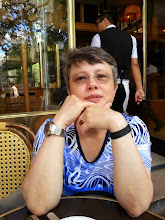"The Ramparts of God's House", 1890, John Melhuish Strudwick, Oil on Canvas, 61 x 85,1 cm, Private Collection
“I am the dream of God
the shard in His chest
the chime beyond the city gate” *
Light. Light everywhere. Golden light. Golden walls. Golden trees, with golden leaves rustling gently in the wind. And the warmth on my face, on my body. My naked body. Here I am, naked among the clothed. The feathered. Man among angels, in their absolute beauty, their timeless perfection. Memories forgotten grace my heart anew. I am alive, on the other side of life, taken outside of time. To see.
When Pre-Raphaelite artist, John Melhuish Strudwick (1849-1937) painted “The Ramparts of God's House”, he was fourty one years old. It was one year before he met with Geoge Bernard Shaw, who would positively review his oeuvre, in the “Art Journal” of 1891. Strudwick studied at the Royal Academy Schools and worked as a studio assistant to Spencer Stanhope and Sir Edward Burne-Jones. He painted some thirty paintings of legendary and symbolic subjects, in a style derived from the Italian Quattrocento. Because of his meticulous style and a lapidary technique, Strudwick's output was very modest and he never really enjoyed public recognition, let alone commercial success.
What is “The Ramparts of God's House”? It is a true Pre-Raphaelite work of art. It is a brightly coloured, evenly lit picture, that appears almost flat. It has the meticulousness, accuracy and great attention to the ornamental and architectural details, one would expect a Pre-Raphaelite painting to have. Strudwick also created a combination of realistic style, almost photographic-like, with elaborate symbolism. In the “The Ramparts of God's House”, Strudwick chose to focus on the episode on Enoch's journey to the Kingdom of Heaven, where God revealed to mankind how He will judge them.
The Book of Enoch is a pseudepigraphal work attributed to Enoch, the great-grandfather of Noah. Scholars date its older section, The Watchers, from 300 BC. This book is mentioned in Genesis 5:21-24. It is the story of Enoch's encounter with the Fallen Angels and their offspring, the Nephilim. It is divided into five books: The Watchers, The Parables, The Astronomical, The Dreams & Visions and The Epistle. It is said that Enoch lived 365 years, most of them with God, who took him by His side. Enoch was with Elijah, the only human being never to see death, for, by faith, God translated him. There are two versions of Book of Enoch, one in Aramaic and the other one in Hebrew.
“I am the tears from Heaven
the lining of His soul
the leafless tree under the crumbled arch” **
What do we see when we look at “The Ramparts of God's House”? Let us start with the obvious. Strudwick was very interested in the mythological as well as purely decorative aspects of his work. For instance, his attention to detail is truly amazing. Even the smallest angels that are shown on the left upper corner of the painting, have halos and wings skillfully represented. Their feathers are meticulously reproduced, as in anatomical diagrams. The artist put the emphasis on the architectural accuracy, choosing to stage mankind's revelation in a highly consistent environment.
Strudwick's fascination for music shows in his depiction of the Fallen Angels' music instruments, namely the harp and the luth. In a way, there is hardly any place in this painting that does not reflect the Pre-Raphaelites' concern for accuracy and recognizable inspiration sources. Everything is well-documented, precise, almost perfect: one would say comprehensive. Strudwick frequently used poetic titles to his paintings, thus underlying the connection between the visual and literary elements of his inspiration, as the Pre-Raphaelite painters were encouraged to do.
What about the less obvious then? Despite its formal perfection and its exhaustiveness, there is still room for surprises in “The Ramparts of God's House”. The Book of Enoch tells us how the Fallen Angels taught mankind the true purpose of music, as a sensory device to open our being to the voice of God. Music's purpose is to assist human soul in its worship of God. But beyond the pure visual delight of this painting, Strudwick also created a more profound, more spiritual environment. Oddly enough, “The Ramparts of God's House” do not prevent us from seeing anew, from seeing within. There is a connection between this Pre-Raphaelite artwork and Visionary Art. In both cases, we are invited to see beyond the image, to let all our senses partake into a wider sensory experience. As with Byzantine icons, the third dimension – the depth - of the image is omitted, as an invitation to see beyond what the eye can see, to step into the invisible.
In “The Ramparts of God's House”, Strudwick created an imaginary space that has the hypnotic and mysterious power of a religious icon, although it is very doubtful that he thought of his painting that way. Of course, Strudwick's vision of our biblical past is questionable. Nobody knows how Enoch looked like. How was it to walk with God? Can Heaven really be the way Strudwick painted it? Perhaps, it is precisely because of a certain rigidity of style and the rather impersonal nature of his characters, that “The Ramparts of God's House”, appear to be timeless? Haunting, beautiful and somehow visionary, “The Ramparts of God's House” have the soul-shattering effect of an intimate epiphany. In their own way, they offer us a glimpse at the invisible realm, a powerful gateway to reach paradise. Paradise lost.
“Light, light was His name
and the flood
the stars
the tale beneath the canopy
the faint echo across the weft of time
Elohim, Elohim!” ***
* Poem by Ariane Kveld Jaks
** Poem by Ariane Kveld Jaks
*** Poem by Ariane Kveld Jaks













